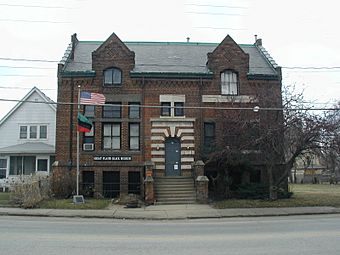Webster Telephone Exchange Building facts for kids
Quick facts for kids |
|
|
Webster Telephone Exchange Building
|
|

The Webster Telephone Exchange Building
|
|
| Location | 2213 Lake Street, Omaha, Nebraska |
|---|---|
| Built | 1907 |
| Architect | Thomas R. Kimball |
| Architectural style | Tudor Revival |
| NRHP reference No. | 77000829 |
| Added to NRHP | December 5, 1977 |
The Webster Telephone Exchange Building is a special place in North Omaha, Nebraska. A famous architect named Thomas Rogers Kimball designed it. After a big storm called the Easter Sunday Tornado in 1913, this building became a central spot to help people recover.
Later, in 1933, the American Bell gave the building to the Omaha Urban League. This group is now known as the Urban League of Nebraska. The building has 33 rooms and is very important to the history of Black people in Omaha. It was home to the Urban League and its leader, Whitney Young. In 1976, it became the Great Plains Black History Museum. The building was added to the National Register of Historic Places in 1977. It was also named a landmark by the City of Omaha.
Contents
A Look Back: The Building's Story
Early Days as a Phone Center
The Webster Telephone Exchange Building first opened on June 9, 1907. It was called "Lake Exchange" back then. The Nebraska Telephone Company used it as one of their main phone centers. The building has a unique Tudor-style look.
Helping After the 1913 Tornado
In 1913, a powerful storm, the Easter Sunday Tornado, hit Omaha. The Webster Telephone Exchange building became a key place for helping people. Telephone operators bravely stayed at their posts during the storm. Even with broken glass and many problems, they kept the phone lines working right away. People who were hurt in the nearby Near North Omaha area were also brought to the building for help.
A Community Hub for Omaha's Youth
In 1933, the phone company gave the building to the Omaha chapter of the Urban League. It became the Mid-City Community Center. This center served the Near North Side neighborhood. It had many helpful things for the community. There was a library, a nursery for young children, and clinics for dental and medical care. It also had classrooms for learning.
A future national civil rights leader, Whitney Young, had his offices there in the 1940s. The community center moved in 1956. After that, the building was changed into apartments. In the 1960s, it was the main office for Great Omaha Community Action.
Becoming a Black History Museum
In 1975, James T. and Bertha W. Calloway bought the building. They wanted to create a museum about African American history. Soon after, the family gave the building to the new Great Plains Black History Museum.
Recognized for Its Importance
The building was added to the National Register of Historic Places in 1977. This was because of its special design and important history. The building was closed to visitors in 2004. It needed a new roof and other repairs after being used for almost 100 years.
Explore More



